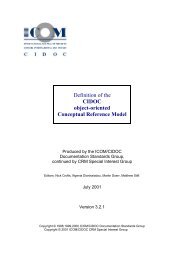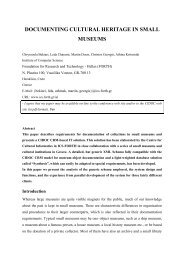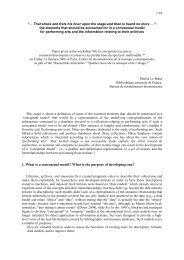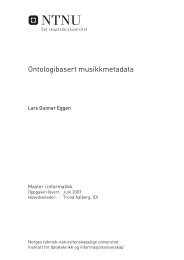Ontological Requirements for Annotation and ... - The CIDOC CRM
Ontological Requirements for Annotation and ... - The CIDOC CRM
Ontological Requirements for Annotation and ... - The CIDOC CRM
Create successful ePaper yourself
Turn your PDF publications into a flip-book with our unique Google optimized e-Paper software.
A philosophical-theory does not differ much in its <strong>for</strong>malization from its direct superclass,apart from the fact of having range branch-of-philosophy on the property exists-inarea.<strong>The</strong> same property, instead, would have value scientific-area in the case of ascientific-theory. Moreover, a scientific-theory can be further defined as having amore peculiar relationship to the facts it tries to explain, as it is usually required to beverified (proved) by them, <strong>and</strong> to be able to predict them too.3.5.3 Philosophical-systemA philosophical-system might appear as a theory, at first sight, but it differs from itessentially <strong>for</strong> its generality <strong>and</strong> breadth. That is, because it spans over various problemarea,while a theory is usually confined to one problem-area only. As a consequence,theories are usually part-of philosophical systems. We can there<strong>for</strong>e define a system asthe set of a personʼs views (which singularly taken, approach problems coming fromdifferent problem areas) which are consistently connected to each other, in such a way to<strong>for</strong>m a unity.In a way, this class refers to what is normally called the ʻphilosophyʼ of a thinker. So, <strong>for</strong>example, we can have the “Epicurean philosophy”, the “Kantian philosophy” or “Humeʼsphilosophy”. We must remember, however, that this class does not correspond to the meresum of an author's theories: in fact, thinkers might produce more than one independentsystem, during their lifetime (e.g. the first philosophy of Wittgenstein, as opposed to thesecond one).Finally, we also recognized how a philosophical-system (although being inherentlyrelated to various problem-area) is often considered as representative of a school-of -thought (which, as explained in the next section, is instead usually related to a specificproblem-area). In other words, it makes sense to say "the philosophy of Hume isscepticism", even if, in such a case, we implicitly refer to only certain aspects of hisphilosophy (i.e., his epistemology). As this is a normal practice <strong>for</strong> scholars, we reckonedimportant also <strong>for</strong> our ontology users to be able to quickly classify philosophies using thepart-of-school property, without having to specify the relevant theories or thesis. In order toprevent wrong generalizations (e.g. inferring that all the theories of Hume are “sceptical”)we use a set of purpose-built rules. Finally, other rules also guarantee the consistencybetween philosophical-systems <strong>and</strong> the theories composing them (e.g. if a theory definesa method or a concept, the philosophy comprising the theory is also considered to definethem).3.5.4 School of thoughtThis class refers to the set of theory-types, or generic st<strong>and</strong>points, which in the history ofthought have acquired a particular significance <strong>and</strong>, seemingly, a life on their own. <strong>The</strong>ycorrespond to widely known conceptions, or st<strong>and</strong>ardized intellectual trends that hint attypical ways to answer a problem (or a set of problems). Examples are “pacifism”,“animism”, “expansionism”, "empiricism" or "monism".Sometimes they can be so abstract (as in the case of "monism") that they do not implyanymore than a link to a specific problem or area, but refer only to the ʻ<strong>for</strong>mal featuresʼ of













